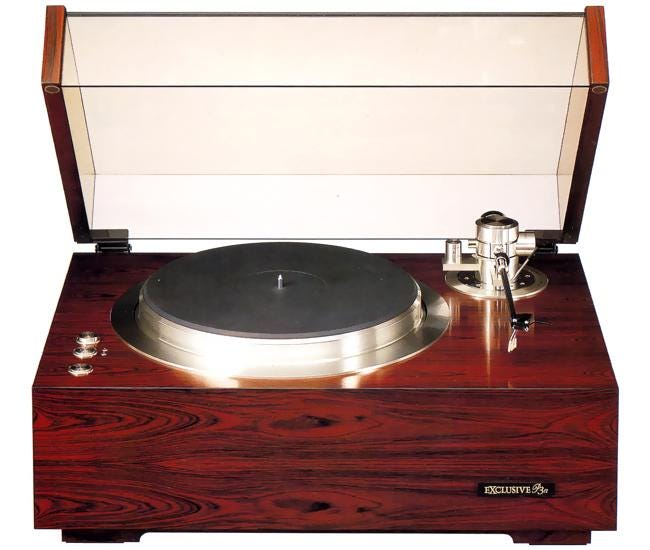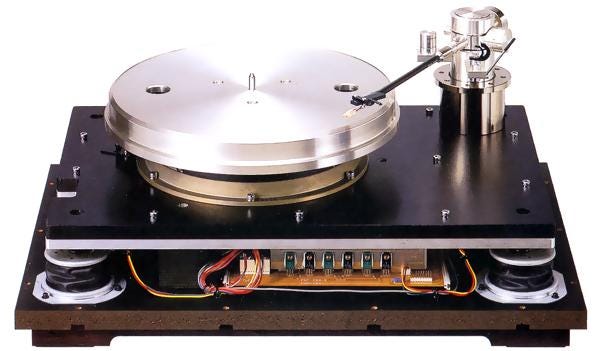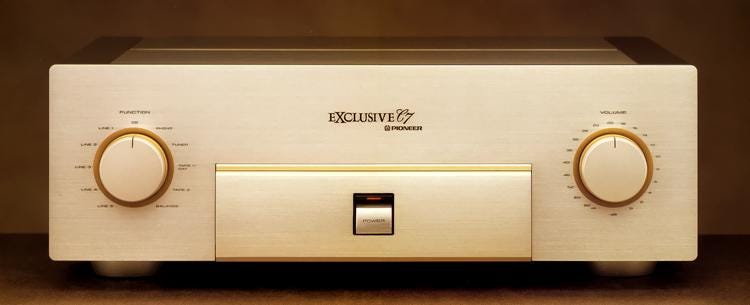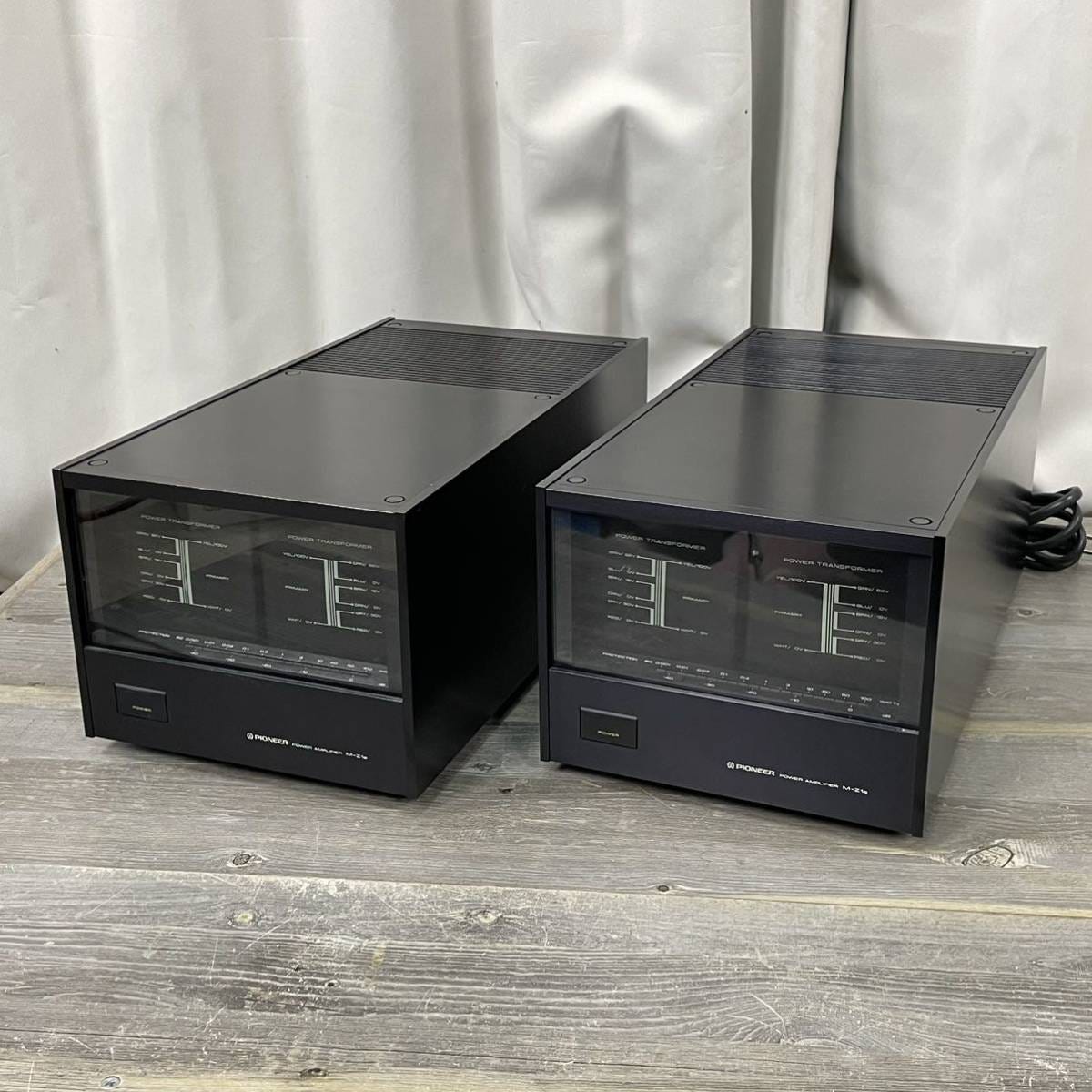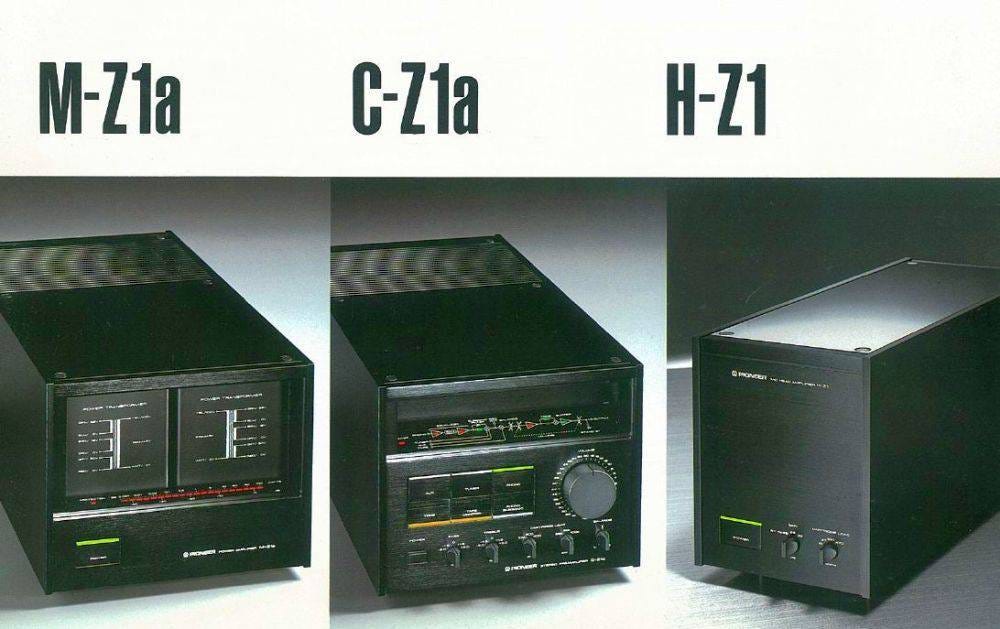This is part of a series on turntables, many of which are going to be Japanese turntables because, well, I know them and they’re pretty great turntables.
The Exclusive P3 (and P3a) Turntable
This is one of the coolest turntables technology-wise to grace the showrooms of Japanese audio makers in the past 50-80 years. It is one of my favourites.
It arrived on the scene as the Exclusive P3 in 1978 at the princely sum of ¥530,000 - about half the price of a new high-end Toyota Corolla (the picture below is of the P3a which was the higher-priced update in 1981 - outwardly they are exactly the same except for the name badge on the front).
Exclusive was the high-end in-house brand for Pioneer, which also sold stereo equipment under its own name. Exclusive was the product of a kind of high-end skunkworks in the engineering department in the 1970s which led to the introduction of their best (and highest-priced) technology. Everything was expensive, and extremely well-engineered. Amplifiers and preamplifiers and turntables were sold in multiples of several hundred to a few thousand rather than tens and hundreds of thousands.
Above is the way it looked from the outside. Below is what it looks like if you remove the arm, remove the heavy rosewood veneer shroud and top cover (and put the armbase back in), all nekkid and stuff.
The P3 had a heavy platter, a 25kg base and sub-base (the nekkid pic above) which had dampeners - steel spring coils housed in oil-filled sheaths on all four corners under the sub-base.
Weight is a key factor in high-end turntables because mass reduces transmission of micro-vibrations, and rotating weight (the platter) means a super-high moment of inertia, which means a) it is difficult for outside force artefacts to impact the speed at which the platter and record are spinning, which is always a thing, and b) the manufacturer has bragging rights for the heaviest platter and most powerful motor, and those bragging rights were a thing, but didn’t necessarily need to be.*
The P3 is a direct-drive turntable. That means the motor turns the platter rotor itself, rather than having the motor pull a belt which turns the platter, or turns a wheel, which itself applies force to the spindle or platter (via rubber wheel) to turn it (like an idler drive).
The P3/P3a uses what it calls a Stable Hanging Rotor system (which sets the center of gravity of the platter quite low compared to the bearing, which is lifted to the top rather than sit at the bottom of the motor), around a high-torque (10kg-cm, similar to a record-cutting machine) slotless, coreless, linear motor and the circuitry chops to control it. It could apparently withstand putting a 1.5kg weight on the stylus (600-1,000 times the normal Vertical Tracking Force of a stylus) and it would not change speed. Normal rotational speed accuracy was 0.001%.
The tonearm had multiple armwands available (sold separately); the J-shape or S-shape carbon fibre wand is for higher weight/lower compliance cartridges, the light straight wand (shown below as the upper of the two) for high compliance carts was an alumina ceramic material. The tonearm itself is highly-engineered, and has oil damping in the top. It is near magic, and the tonearm was available separately for ¥160,000, which was a lot of money for a tonearm back then (still is 40 years later).
The P3 had almost everything optimised, but that was the era of high inflation so to be able to raise the price in 1980-1981 to match/beat the new Technics SP-10Mk3, the P3a was launched with ‘upgrades’. The new price was ¥600,000, which was 25% of an average annual salary at the time. That was lifted to ¥650,000 in 1983.
The upgrades were numerous, but minor, with the only “real” differences limited to a slightly lower capacitance phono cable, and a little dampening weight on the straight P3a armwand called a Dynamic Resonance Absorber (shown above - the silver bullet shape near the aluminum base on the straight arm, and the black thing with gold lettering around the J-shape wand) which makes the straight arm a bit more flexible to use with lightweight high compliance cartridges, and reduces resonance on the J-shape wand when using low-compliance cartridges (the P3 armwands lack the silver bullet and the band around the S-wand, and while they are great, the P3a armwands with the ugly things in the middle of the wand are better).
The other thing done which the engineers were proud of was to vary the thickness of the metal base (seen as the top black plate in the photo above, under the platter and motor) so as to do a better job of balancing the lateral forces affecting the center of gravity (because the weight of the motor is not completely centred). Given the thing hardly ever moves, and if it moves enough to require the effectiveness of varying plate thickness you have serious problems like an earthquake, this is engineering for the sake of engineering. But they thought they had “missed” that the first time around so they “did it right.”
Between the original P3 and the P3a, the signal to noise ratio pops from 78dB to 95dB as well. And that is a shocker. It’s magic. The trick here? Sometime in the very early 1980s, the EIAJ (Electronics Industry Association of Japan) changed their DIN B measurement methodology to, according to the marketers, “better measure what the ear hears” (they changed something to account for the shape of the human ear). Left largely unannounced (I had to dig to get this information years and years ago), they “flattened” the weighted curve, and added another filter, which had the effect of raising S/N ratios by “about 20dB” depending on what equipment was being measured. The P3 and P3a are, by the newer DIN B standard, statistically the same. They basically sound the same. If you find one of each at the same price, buy the P3a but otherwise, the P3 will knock your socks off too.
There is a slight difference in speed drift in the control circuitry. The P3a originally had half the speed drift of the P3. However, when the wonks at the service centre in the outskirts of Tokyo outside Shibuya repair a P3, they set the speed drift to P3a control specs. The only way to really check the differences between the various high-end tables from Technics, Denon, Exclusive, Onkyo, Luxman, Kenwood, and others would be to use the JIS rumble measurement which was used continuously from the late 1960s or early 1970s onward, or to test everything using the newer DIN B standards. Across the years and specs, DIN B itself changed dramatically.
The turntable has a quite luxurious look, with a Brazilian Rosewood Veneer, the use and import of which was later restricted by the CITES Convention. I do not know if this turntable can be exported, even secondhand, to markets outside Japan, though trade in musical instruments has been exempted from the rule in recent years, and this turntable pre-dates the restrictions. Furthermore, while you can get letters of exemption to the CITES convention if your object adheres to the exemptions (and I do not know that this does), getting someone in the bureaucracy to care enough to actually consider a case previously unconsidered may be a lost cause.
*Regarding “weight” and “high-torque motors”, people who really look at the problem have in many cases decided they wanted to have heavy platters and massy plinths but very low-torque motors which had no ability whatsoever to radically change the speed of the platter. The better the bearing, the heavier the platter, and the lower the torque of the motor, the less chance of ever creating any speed change which is audible. So there are some specialty turntables out there which use dual motors, one high-torque motor to spin up the platter at start-up and one low-torque low-power motor to maintain speed while playing the record.
What Does It Sound Like?
Magic. I love it. It is pure heaven for vinyl. It does equally well with high compliance cartridges and super heavy low-compliance carts like the Fidelity Research FR-7f (using the S-shaped arm). In this respect, the P3a wands are slightly better.
I do not know whether it is the resonance dampening, or the the rigid armbase connection to the dampened platin, or whether it is the motor, which seems smooth as silk. I expect it is a combination of everything. The turntable is pure lusciousness.
But there is something about slotless, coreless, linear motors which sounds really, really great. Even some of the top turntables with the best underlying tech otherwise - such as the Technics SP10 Mk 3, similarly priced in 1983 - somehow have a trifle less smoothness, as if the different motor technology was introducing something into the rotational force equation.
I have had A/B (or A/B/C/D/E/F/G) setups with the Exclusive P3a, Technics SP-10Mk3, the Denon DP100M, the Kenwood L-07D, and others and the Exclusive P3 comes out in the top 2 every time among direct-drive turntables (the Denon DP100M is pretty tough to beat).
The Pioneer Skunkworks Inside the Pioneer Skunkworks
For true connoisseurs, Pioneer created a skunkworks inside its skunkworks. The Pioneer engineering department was responsible for the Exclusive brand, and they made top-notch solid state mono amplifiers and control amplifiers (pre-amplifiers), top-notch speakers, and a couple of ridiculously-priced accessories which could be bought for a tenth the price from another brand (even Pioneer). They only made one source component in two grades to my knowledge - the Exclusive P3/P3a, and a slightly lower-market P10 turntable. Nothing else.
But that was not enough. Exclusive was a brand where the electronics were all champagne-coloured, with very simple surfaces. They look high-end. The fantastic dual mono C7 pre-amplifier which cost ¥1,200,000 some 33 years ago (about US$8000 equivalent in 1990) and it oozes 1990-era luxury.
This was brute force technology refined to its ultimate - using only the best components and discrete circuitry techniques. Then do that for every part and aspect of the circuit.
Originally, the Exclusive amps used FET amp and control amps which had local current feedback, but minimal Negative Feedback (NFB is usually used to lower distortion). The linearity of the circuit got them minimal distortion and favourable rise characteristics. They got power by using push-pull circuits. They used very large power supplies. In the 1980s they went with zero Negative Feedback, and even more linear semiconductors. That would leave you with higher “distortion” using a THD (Total Harmonic Distortion) calculation used by the industry, but it would usually sound waaaay better than the cheaper products with ‘better’ THD characteristics.*
*The reason why high-end amplifiers with higher distortion numbers sound better than less expensive amplifiers with better/lower distortion specs is where the distortion shows up. In high-end Class A circuits, second order harmonic distortion can be relatively high. But the ear likes second order distortion. It is the reason why tube amps sound “warm”. Third and fifth order harmonics are really, really obnoxious. They sound awful at 0.10%. 2nd order harmonics sound fine at 3% as long as third order is down at 0.001%.
In the late 1970s when Exclusive had started making the Exclusive brand amps, there was another group working on a kind of ‘super-technology’. They tested the Exclusive stuff and tried to find weaknesses. Then they went funky.
They used the concept of super-linear circuits where they took their best non-linear transistors and put them back to back with reverse mode non-linearities, allowing for cancellation of the non-linearities. They put the transistors in parallel to lighten the load per transistor to produce pure Class A amplification, and the lighter load improves high-frequency reproduction. They directly-coupled all the stages eliminating the need for coupling capacitors. This requires more accuracy and stability in the circuit, but it can be magic.
In the carbon resistors, they replaced the iron cap with a brass cap to reduce distortion.
They used custom capacitors made with OFC copper foil for the small capacitors, and the electrolytics used extremely pure electrode foil material, then the capacitors were coated with carbon, then glass coated (rather than a normal aluminum housing).
The PCBs used glass epoxy, OFC for the signal wiring everywhere - wires, flow, fittings, everything - and made the copper foil 140 microns thick, which was four times conventional thickness, thus reducing DC resistance and inductance.
The chassis and frames were made with non-magnetic materials in every way. Then they were coated with a special resin for shielding purposes. There are two power transformers in parallel per monoblock, and they are potted in a carbon resin which eliminates vibration and provides shielding.
Basically, they took every part out of the Exclusive equipment, made it as good as they could make it, further cleaned up the circuits to eliminate all NFB, local and whole, and then custom-produced each part to be like a super-part equivalent of an Exclusive amp. The M-Z1 amps are full Class A which means they pull about 220 watts from the wall to produce a maximum of 60 watts of amplifier power. They were ¥300,000 a pop in 1979. And that’s for one. You had to buy two. They were simple on the outside. They take about 30 minutes to “warm up” but otherwise, they are simple monaural amplifiers. A couple years later they issued the M-Z1a, also the same, but with better power cord.
The control amp was called the C-Z1 (there was a later C-Z1a). It was, frankly, a little less special. They used all the techniques they used in the amp. It is effectively a no-negative feedback circuit (there is a little non-returning NFB in the signal system from input to output, which is a trifle disappointing and one imagines they couldn’t find a way to get rid of it). All stages are direct-coupled. No coupling capacitors here either.
The superlinear circuit is effectively a current amplifier so gain is determined by load resistance. They used that feature to create a current equaliser with RIAA characteristics, which changes the sensitivity of the RIAA equaliser circuit, giving higher gain.
There was also a piece called the H-Z1. It was a head amp. This is commonly also called a pre-pre amp.
A turntable with a moving magnet cartridge produces a fair bit of current - about 2-7 millivolts. The signal is carried down through the lead wires to the tonearm cable to the phono cable which ends up connected to the C-Z1a preamplifier phono stage section, where it is amplified about 400 times from 5 millivolts to 2 volts or so, then the pre-amp gain stage pushes the power higher, then the volume knob ‘takes away’ signal power as the preamp outputs to the amplifier. The amplifier has a couple of gain stages inside it and then produces a much stronger signal which “drives” the speakers.
However, a moving coil cartridge like my old favourite Fidelity Research FR-7f (or z) or the Victor MC-L1000 which is an even weirder coil, puts out somewhere between 0.1mV and perhaps 0.25mV. That means a truly tiny electrical signal has to be amplified 20-50-fold just to get to the level of a moving magnet cartridge output in the 5mV range. Sometimes these cartridges have very, very low coil impedance, so something has to be done there too.
There are two ways to accomplish this. One can use transformers, or one can use an electronic amplification device like a head amp.
The Pioneer H-Z1 (they didn’t make a H-Z1a) uses super-linear FET circuits, a ridiculously-spec-ed custom toroidal transformer with a silicon carbide shield to protect from any external magnetic fields. They made custom film capacitors, with custom coating and custom shielding. The amps use 140u OFC foil. This head amp uses 280u 99.99% pure OFC (oxygen-free copper) foil. The fuse is pure copper, rather than brass. Electrode plating material was changed to tin from the normal nickel (because nickel is slightly magnetic). And because there are tiny non-linearities when two metals meet in a circuit - such as solder points - they use 99.99% pure OFC wire in every wire and trace, and they even use solder containing copper for the solder points.
They shield everything because even with tiny signals, electromagnetic interference is generated from current flows, affecting any and all magnetic metal parts (and circuits). The glass-coated capacitors eliminate eddy currents, the transformers are super-potted. And the H-Z1 uses electromagnetic wave-absorbing material everywhere inside to eliminate interference. The top plate is made of glass with a silicon carbide coating as an additional electromagnetic shield.
The thing is ridiculous, and I am certain they lost money making every one of these. But it is like an auto-manufacturer sponsoring an F-1 team. You do absolutely everything you can, some of the tech trickles down (or up), and eventually you find out what works. And you use what you can at scale to make your products better. Japan R&D is like that.
But these parts and processes were never going to be scalable. They sold quite a few M-Z1s and C-Z1s (and a few H-Z1s) in the very early 80s at high-end shops, but by the mid-80s Pioneer gave up on these and the Exclusive range adopted the zero NFB circuits and some of the fancy stuff in the control amp. It was really tough to sell amps at ¥600,000 with a Pioneer logo when the Exclusive logo items looked more, well, exclusive, and cost about the same or just a trifle more.
The Exclusive turntables were made until the late 80s or so and the amps and speakers into the noughties, and I remember seeing one of these turntables in the exclusive (and usually empty) Exclusive showroom in the Pioneer headquarters in Meguro in the early 90s, which is when I discovered this brand existed, long before I could dream about owning any of it.
How Do These Sound?
A dream. The amps and headamp are, to this day, the best at what they do that I have personally heard. Ever.
I bought a pair of the amps. Then the head amp. Then the control amp. I ended up buying doubles and triples of the amp and head amp for replacement parts should the semiconductors ever go. There are other Class A solid state circuitry amps which do really well, designed by circuit designers who really, really know their stuff. Some of the super low power Class A amps designed by Nelson Pass are great. I have listened to others in the mega-buck range. But I have never come across a set of amps I would rather have. At 60W per channel they don’t have enough to power low-efficiency speakers, but with anything above about 90dB, they are magically liquid and luscious, with a smoothness and refinement which is quasi-unbeatable and a noise floor which is truly very, very low. They sound like the best tube amps, but with a lower noise floor.
The headamp is great. Accuphase - a high-end specialty solid state amplification company in Japan - also made a top-end-of-the-range head amp. I bought one of those. I sold it and bought a second H-Z1 just in case.
The C-Z1 control amp is pretty great. I have one of them too. I think it probably can be improved upon, but it would cost a very pretty penny (probably an MSRP of 10-20x what one of these costs used). I have a tube pre-amp which I prefer.
Unfortunately, none of this series was ever marketed/sold outside Japan, so one has to make one’s way there, or find a way to buy it remotely (not impossible these days).




